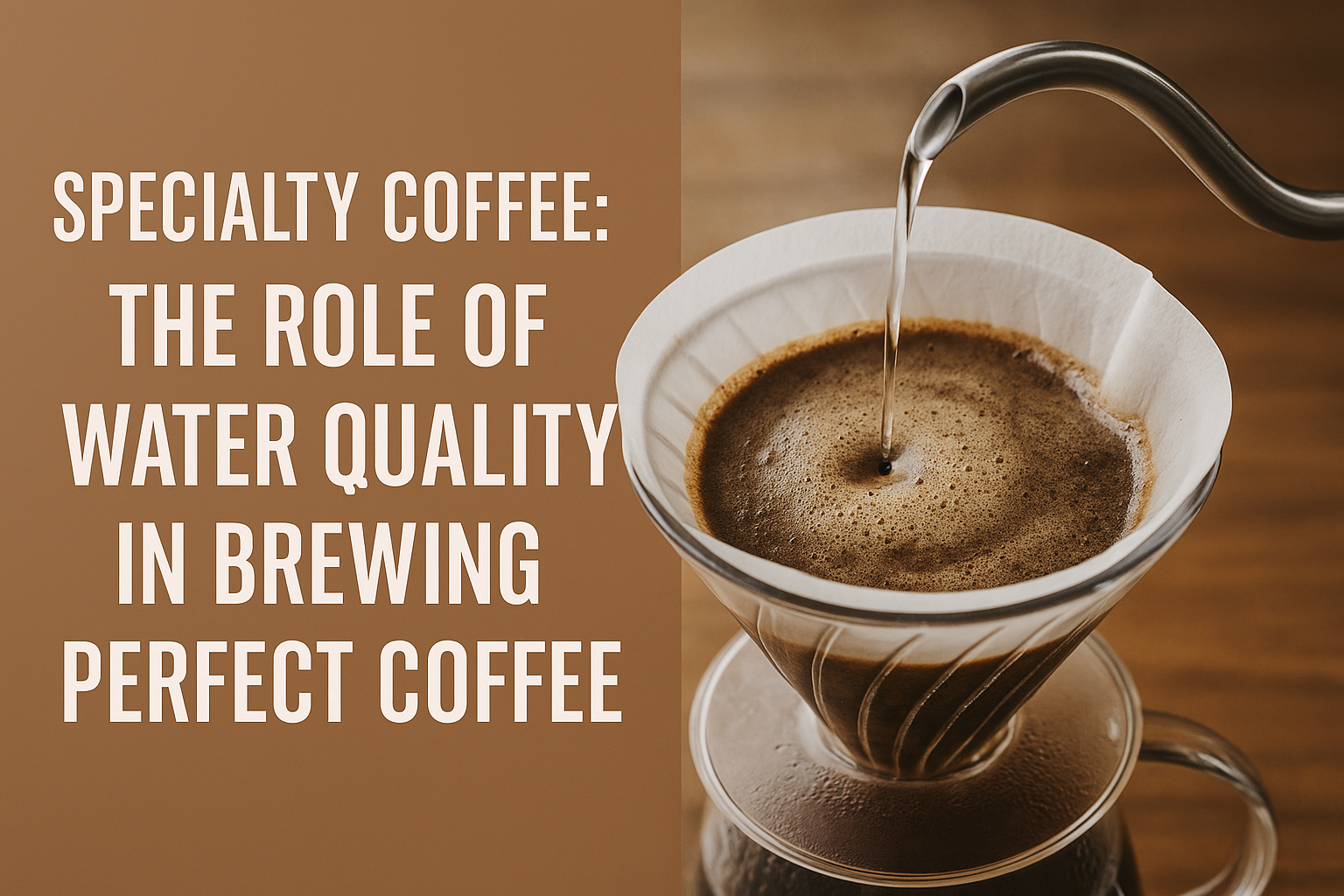When we think about brewing specialty coffee, we often focus on the beans, the roast, and the equipment. But there’s another element that makes up more than 98% of your cup — and it’s often overlooked: water.
Water isn’t just a medium that passes through the coffee grounds. It’s a chemical agent that extracts flavors, oils, and soluble compounds from the beans.
The quality and composition of the water you use can drastically affect the clarity, balance, sweetness, and even bitterness of your brew.
As a barista, understanding water quality is essential for consistency, flavor control, and delivering top-tier coffee. In this article, you’ll learn how water affects brewing, what makes water “good,” and how to improve it for better coffee results.
Why Water Matters in Specialty Coffee
Water is the solvent in the brewing process. As hot water passes through coffee grounds, it dissolves various compounds — acids, sugars, oils, and plant material — each contributing to flavor.
If the water is too soft or too hard, it can:
- Under-extract or over-extract flavors
- Mask subtle notes like florals and fruits
- Enhance bitterness or dullness
- Introduce unwanted flavors (chlorine, metal, sulfur)
That’s why professionals treat water as a key ingredient, not just an afterthought. The better your water, the better your brew.
What Is “Good” Water for Coffee?
The Specialty Coffee Association (SCA) provides guidelines for ideal brewing water. These aren’t rules — they’re targets that help you achieve balance and clarity in the cup.
Here are the most important water parameters:
- TDS (Total Dissolved Solids): 75–250 ppm (ideal around 150 ppm)
- Calcium Hardness: 17–85 ppm
- Total Alkalinity: 40 ppm
- pH Level: 6.5–7.5
- No chlorine or odor
- No heavy metals or contaminants
These measurements might sound technical, but they’re essential for professional brewing. Each element plays a role in how well the water extracts flavors.
Let’s break them down.
Total Dissolved Solids (TDS)
TDS measures how much “stuff” is dissolved in the water — minerals, salts, organic compounds, etc. It’s measured in parts per million (ppm).
- Too low (<75 ppm): Water may under-extract the coffee, resulting in sour or weak brews.
- Too high (>250 ppm): Water may over-extract, causing bitterness and muddled flavors.
The sweet spot is around 150 ppm, where water can extract flavors effectively while maintaining clarity.
Calcium and Magnesium (Hardness)
Hardness comes from minerals like calcium and magnesium, which bind to compounds in coffee during extraction. These minerals also contribute to mouthfeel and perceived sweetness.
- Calcium: Enhances body and extraction
- Magnesium: Accentuates brightness and acidity
A balance between the two brings harmony to your cup. However, too much calcium can cause scale buildup in espresso machines, while too little can lead to flat flavor.
Alkalinity
Alkalinity measures how well water resists changes in pH during brewing. It’s like a buffer that helps stabilize acidity.
- Low alkalinity (<40 ppm): Water can become too acidic, making coffee sharp or sour.
- High alkalinity (>100 ppm): Water may neutralize acidity, leading to a dull or chalky cup.
Ideal alkalinity keeps your coffee lively but smooth — especially important for light roasts and fruity profiles.
pH Level
The pH scale measures acidity vs. alkalinity. Neutral pH is 7.
- Too acidic (<6.5): Water can over-extract acids and create sharp, sour notes.
- Too alkaline (>7.5): Water may flatten the cup and extract bitter compounds.
Aim for a pH between 6.5 and 7.5 for best results.
Chlorine and Off-Flavors
Municipal water often contains chlorine or chloramine for sanitation. Unfortunately, these chemicals ruin coffee flavor by reacting with organic compounds.
Chlorine in water can result in:
- Bitter or chemical taste
- Suppressed aroma
- Unstable extraction
Always use filtered water to remove chlorine and any off-smells or tastes. If your water smells like a swimming pool, it’s not ideal for brewing.
How to Test Your Water
There are several ways to test water quality:
- Home TDS meters: Affordable and easy to use for checking mineral levels
- Water test kits: Measure pH, hardness, and alkalinity
- Laboratory testing: Best for cafés wanting detailed water profiles
Some roasters and cafés test water weekly to ensure consistency across brewing methods.
If you’re brewing at home, testing once every few months is enough — especially if your taste results start to change unexpectedly.
Water Sources and Their Challenges
Here’s a look at common water sources and what to watch for:
Tap Water
- Pros: Convenient and cheap
- Cons: Inconsistent mineral content, often contains chlorine
Use a carbon filter or reverse osmosis (RO) system to improve tap water. RO systems remove almost everything, allowing you to remineralize with custom formulas.
Bottled Water
- Pros: Easy and usually clean
- Cons: Expensive and varies by brand
Not all bottled water is good for coffee. Avoid “purified” or “distilled” water — they lack minerals and can result in flat coffee. Look for spring water with moderate TDS.
Distilled or Deionized Water
- Pros: Very pure
- Cons: Lacks essential minerals
These waters are too “empty” and lead to poor extraction. However, they’re useful if you want to build your own brewing water using mineral concentrates.
How to Improve Your Water for Brewing
If your water isn’t ideal, there are several ways to adjust it:
- Use a home filter: Removes chlorine and improves taste
- Install a water system: Like BWT, Everpure, or reverse osmosis with mineral cartridges
- Use coffee-specific water additives: Like Third Wave Water, which lets you control mineral content precisely
For many baristas, adding minerals to distilled water is the best way to create consistent, ideal brewing water. It may sound extreme — but once you taste the difference, you’ll understand why.
How Water Affects Brew Methods
Different brew methods interact with water in unique ways:
- Espresso: Very sensitive to water quality due to pressure and temperature
- Pour-over: Requires clean, balanced water to highlight acidity and clarity
- French press: Can tolerate slightly harder water due to immersion style
- Cold brew: Often brewed with filtered water to reduce bitterness
In general, better water equals better flavor. Once your water is dialed in, everything else becomes easier.
Talking About Water With Customers
Most café customers don’t think about water, but some will ask — especially if they’re passionate about flavor.
You might say:
“We use filtered water with balanced minerals to bring out the best in each coffee.”
Or:
“Water makes up most of your cup, so we treat it like an ingredient, not just a tool.”
This simple explanation helps customers appreciate the care behind every drink — and positions you as a knowledgeable barista.
Caring for Equipment with the Right Water
Beyond flavor, good water also protects your gear. Hard water leads to limescale buildup in espresso machines, kettles, and brewers. This reduces efficiency, damages internal parts, and ruins temperature control.
Using softened, balanced water extends the life of your equipment and reduces maintenance costs.
Many café machines come with built-in filters, but even at home, using filtered water can save money and prevent breakdowns.
Final Thoughts: Don’t Underestimate Water
Water quality is one of the most underrated tools in your barista skillset. You can have the best beans and perfect technique, but if your water is off, your coffee will suffer.
By learning how to assess, adjust, and respect water, you take another step toward true coffee mastery. It’s the invisible ingredient that makes all the difference — in taste, aroma, balance, and texture.
So next time you brew a cup, think beyond the beans. Think about the water — because great coffee begins long before the first drop falls.

Marcelo Rodrigues is a passionate barista with over 7 years of experience in specialty coffee. He’s worked in top cafés, led barista training sessions, and now shares practical tips to help beginners and coffee lovers improve their skills. Through this blog, Marcel makes the world of coffee more accessible—one cup at a time.

